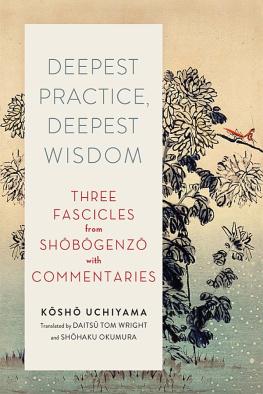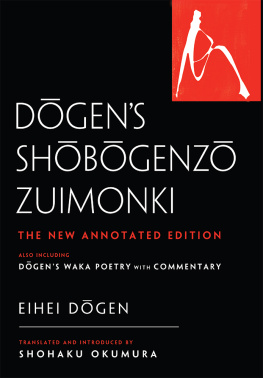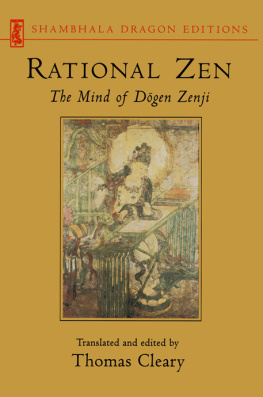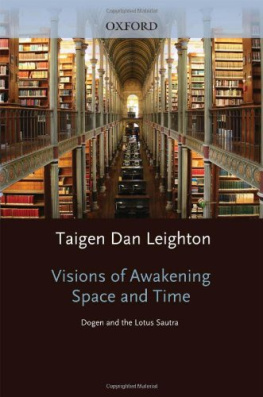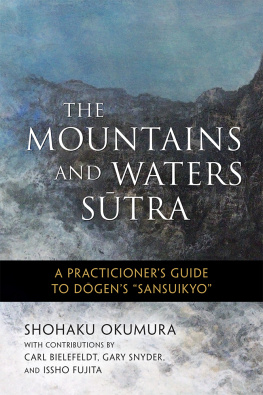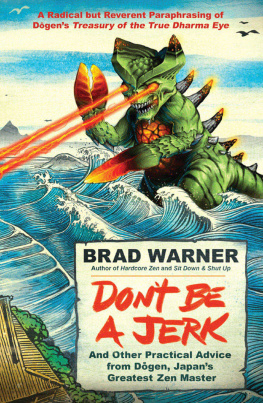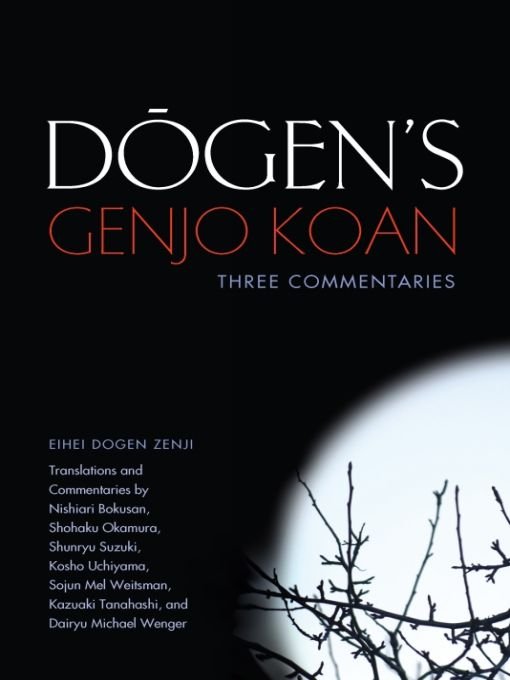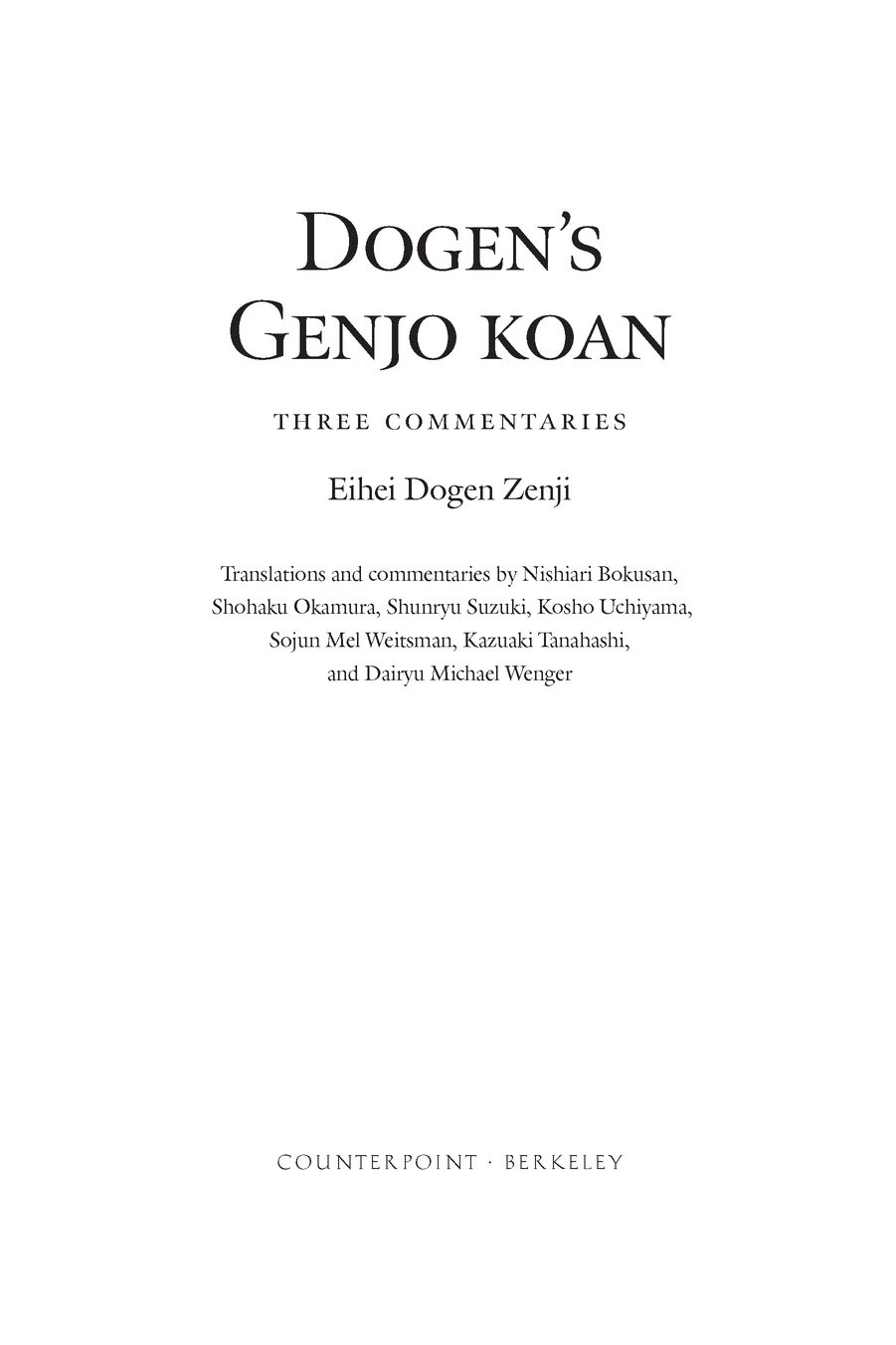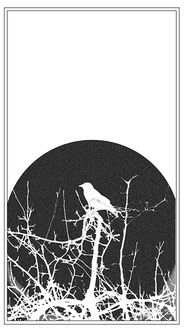Table of Contents
INTRODUCTION:
Three commentaries on Dogens Genjo koan
DOGEN AND THE GENJO KOAN
ZEN MASTER EIHEI DOGEN (12001253), a man of many talentspoet, monk, thinker, and creative essayistbrought Soto Zen from China to Japan. Though he lived but a short time his writings and his enduring presence have had a large and lasting effect, which, if anything, has grown through the years. His collection of essays the Shobo genzo (the treasury of the true dharma eye) is currently the most extensively studied East Asian buddhist work in the Western world. Dogen placed the Genjo koan as the first essay in the Shobo genzo. It has a broad scope, and yet it is full of specific images. It evokes a life dedicated to practice.
The title Genjo koan has been translated in many ways: the question of everyday life, actualizing the fundamental point, the matter at hand, the realized law of the universe, manifesting absolute reality, the actualization of enlightenment, manifesting suchness, living what is, according with the truth.
The essay was written in Japanese rather than the more formal classical Chinese and was dedicated to a lay supporter of Dogens. Its focus on practice in everyday life is what attracts us to it today. How to manifest who we are and who we are becoming is practice.
Genjo koan seeks to address two modalities simultaneously. The first: Dont just do something, sit there; the second: Dont just sit there, do something: being and doing as one.
Dogens rhetorical writing style is a unique one. He will state something and then either partially or totally contradict it with his next assertion. Its the trajectory of the statements, not any one statement alone, that expresses his understanding. It operates in much the same way that koan study does, below the surface of our ordinary discursive mind.
The difficulty of Dogens writing may be one reason why it was kept in manuscript form in the Soto monasteries (not as a working text, but as a symbolic talisman of transmission) and not circulated outside of Sotoshu circles. It wasnt until 1811 that the Genjo koan and the entire Shobo genzo were available in print.
The celebrated poet Ryokan (17581841), lamenting the unavailability of Dogens writings, wrote: For five hundred years its been covered with dust just because no one has had an eye for recognizing dharma. For whom was all his eloquence expounded? Longing for ancient times and grieving for the present, my heart is exhausted.
THREE MODERN COMMENTARIES ON GENJO KOAN
Nishiari Bokusan (18211910) was the most prominent Dogen scholar of the Meiji period. A teacher of Oka Sotan and Kishizawa Ian, the author of Shobo genzo Keiteki, the opening way of the Shobo genzo, he eventually became abbot of Sojiji temple and the head of Soto-Shu. His commentary is the first in this collection. In fact, all of the other commentaries in this volume are in his lineage.
Bokusan said of the Genjo koan, Dogens... entire teaching begins and ends with this essay... the other essays are just offshoots of this one. Nishiari Bokusans importance in modern Japanese study of Dogen led to this translation by Kazuaki Tanahashi and Sojun Weitsman. They translate this work because it is both a traditional commentary and at the same time the focal point of a renewed interest in Japan in Dogens writings.
Shunryu Suzuki (19041971) studied with two teachers who studied with Bokusan: Kishizawa Ian (18651955), his textual teacher, and Gyokujin So-on (18771934), his transmission teacher. He gave his talks in English. He gave six series of talks to his American students on Genjo koan in 1965, 1966, 1967, 1969, 1970, and 1971. Unfortunately, while we have some talks from each series, no series is complete; so they were edited together in order to make a complete commentary. Jeffrey Schneider and I compiled the series into one document, and Sojun Weitsman and I did the final editing of the lectures together. Sojun was ordained by Shunryu Suzuki and received dharma transmission from his son Hoitsu Suzuki. I received dharma transmission from Sojun.
Uchiyama Kosho (19121998) received transmission from Sawaki Kodo (18801965), who studied with Bokusan). Uchiyamas commentary was written in Japanese and translated by Shohaku Okumura, Uchiyamas disciple.
In the 20th century, the work of Sartre and Heidegger, coupled with a thirst for religious practice, triggered a Western interest in Zen Buddhism and particularly Dogens writings. Shunryu Suzuki and Uchiyama Kosen are not only respected in Japan but have also been important teachers in spreading Zen practice to the West.
When Sojun, Shohaku, and I realized that we had three unpublished commentaries on a seminal text from these three exemplars of Dogen studies, we felt this book could help introduce the twenty-first century to Eihei Dogens insight.
Please open your hearts to these great teachers of Soto Zen. May Dogens and their wisdom and compassion help us in these troubled times.
Dairyu Michael Wenger
Beginners Mind Temple
I.
COMMENTARY BY NISHIARI BOKUSAN
Translated by Sojun Mel Weitsman and Kazuaki Tanahashi
TRANSLATORS INTRODUCTION
NISHIARI BOKUSAN, who was also called Kinei Nishiari, was born in 1821. He is regarded as an outstanding mainstream Soto Zen scholar of Dogens Shobo genzo from the last half of the nineteenth century. He was active at a time when Soto Zen scholars and practitioners were beginning to study and make generally available Dogen Zenjis Shobo genzo after an interval of about 500 years. He was considered one of the leading Dogen scholars of his time and had outstanding disciples, such as Kichizawa Ian, who carried on his work. At that time, translating Dogen into modern Japanese was not an easy task, because thirteenth-century Japanese is to present-day Japanese what Chaucer is to present-day English, with the added difficulty of dealing with Dogens unique use of the language. Bokusans student Soei Toyama transcribed his lectures on over sixty fascicles of Shobo genzo, but passed away in 1929. In 1965, Kodo Kurabayashi, a student of Soeis, edited his transcripts of Bokusans lectures on twenty-nine fascicles and published the text as Shobo genzo Keiteki (Shobo Genzo: Right to the Point), in three volumes, from Daihorin-kaku, Tokyo. Genjo koan is one of the fascicles included in Keiteki.
The young Shunryu Suzuki, who was born six years before Nishiaris death in 1910, attended lectures on Dogens Shobo genzo given by Nishiaris disciple and Suzukis second teacher, Kichizawa Ian, whose temple is close to Suzuki Roshis temple, Rinso-in, in Yaizu, Shizuoka prefecture.
When we read or recall Suzuki Roshis talks and his teaching, Nishiaris influence becomes apparent in tracing his understanding, style, and presentation from Nishiari through Kichizawa. Suzuki Roshi is just one example of the influence Nishiari had on his generation of practitioners who were interested in understanding Dogens work.
Nishiari seems to have had a good sense of humor and playfulness, with a down-to-earth, non-dualistic approach, as when he talks about the well-known firewood and ash passage. He says, Go where there is ash and ask, Right now you have a very fluffy body. But you used to be called firewood, which was very solid and flammable when put into a fire. You were burned little by little and got yourself to where you are now. Do you think the ash will agree with this? It will surely reply, Nonsense! I have never met anyone called firewood. And this: The principal of thoroughly experiencing one dharma can be understood through the example of beans and tofu. Beans become tofu. From the tofu makers point of view, beans are boiled and turned into tofu. It appears that beans are before and tofu after. But this is a perspective from outside. If you say to tofu, Your former body was a hard material called beans which I boiled, ground, strained, and hardened with nigiri, and now you have a soft body with a rectangular face, so different from your former body, then tofu would say, This is nonsense. Tofu can never meet beans again. Beans are beans, tofu is tofu. It is not that this turns into that, but there is only one direction at one time; there is only one undivided activity at one time.


